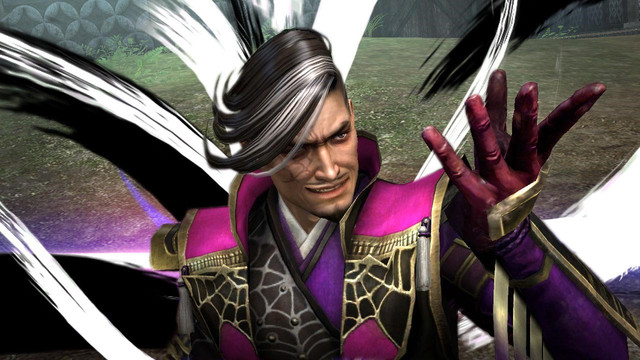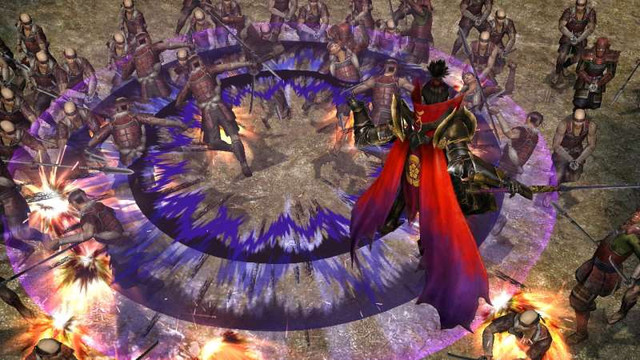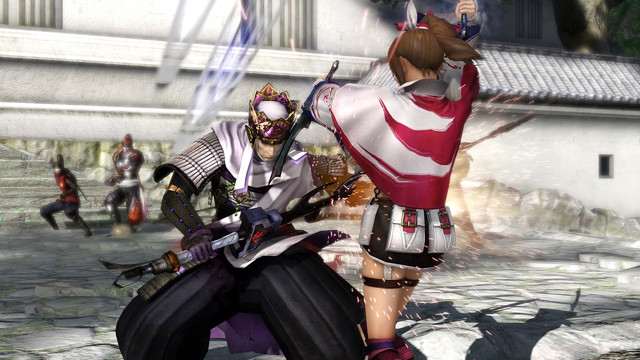It has been a while since I last played a Samurai Warriors title. Like riding a bike, I found myself instantly comfortable with the controls and objectives of the newest release, Samurai Warriors 4. Everything seems so familiar but, strangely, I immediately begin to pick up on small differences that have been implemented so smoothly into the gameplay that it is hard to believe that they weren’t always there. It is difficult to think of Koei as developers as much as evolutionary engineers slowing manipulating the development of a living species with each generation. Having missed several generations, it’s interesting to check back in on the series to try to spot the subtle ways it has improved.

First item on the list? FASHION
In the past, I have found the Samurai Warriors series to be more compelling than its sister franchise Dynasty Warriors. The first Samurai Warriors was released a good seven years after Dynasty Warriors had gotten its start, so the stories and characters still have a bit of newness to them where I’m pretty confident I could recite the history of all the big names of Dynasty Warriors from memory by this point. Additionally, Samurai Warriors also struck me as the more experimental of the franchises, as if Koei was using it to test new features before adapting the more successful titles to their flagship Dynasty Warriors series. This is not to say all of them were great, as one of the worst features was probably the Potential system in the first Samurai Warriors, which awkwardly limited character development in ways largely outside of players' control. Meanwhile, the inclusion of ninja paths was a fairly novel change which was extremely simple, but allowed players to change their approach. It probably wasn't the most groundbreaking idea, but it was definitely something that added depth to the gameplay.

Admittedly I like any excuse to play more Hanzo
The structure of the Story Mode is markedly different from other releases. Rather than each character having their own individual storyline, it is broken up by different clans from which you can select a primary and support character from the clan's unique roster. With each battle, the story of that group's conquest progresses, and various characters have their own personal updates which often occur through character interaction. I think this is an improvement, since the double experience you get from picking two characters and smaller number of storylines allows for the usual massive cast of characters while mitigating the oppressive grind. While perhaps more intuitive at the face of it, the new story structure really reveals some of the awkward aspects of the previous system, since the events surrounding the characters often don’t lend themselves toward making many of them the central focus of a story. Dispersing it over their group really lets you know which events are important since they are given more screen time, rather than small events getting extra attention just for the sake of one character.

Except Nobunaga. He takes all the plot we wants.
It seems like every iteration of the Warriors series increases the body count (sorry, I meant knockouts) attainable in battle. My first three combos in my very first battle of the game netted me something like a 500-hit combo and 100 KOs. I’m not sure if this is a conscious decision, or a result of the increasing processing power available in the new consoles, but it’s nice to see some features that reward attacking troops instead of riding past them to kill their leaders. Let’s ignore the fact that I just endorsed gameplay which incentivises killing as many people as possible (despite the sadistic fun of Shadow of Mordor) and go over the features. There is, of course, the old standby of filling your Musou gauge by racking up huge combos and KO numbers. Now reaching an amazing 1,000 KO count grants you a huge, temporary boost to all of your stats which you can use to strategically break into quadruple digits just before more difficult boss fights. The morale system also encourages ravaging the enemy lines and killing lesser units such as standard bearers to weaken the entire enemy army and make things a bit easier.

All you are to me is free stats
It’s difficult to provide a great deal of insight into a Dynasty Warriors or Samurai Warriors title. The have a combined 12 releases not counting the numerous spin offs such as Warriors Orochi, Hyrule Warriors, and Dynasty Warriors: Gundam. While each game introduces a few new features, the gameplay and the story remain extremely stable. To outrageously oversimplify things, I see this as leaving you in one of three schools: first, if you enjoy this type of game, then Koei Tecmo has spent almost 15 years fine-tuning the experience to make an extremely strong title just for you which guarantees hours of replay leveling your favorite characters and securing epic gear. Second, if you didn’t like any of the past titles, then you are just about guaranteed not to like any future titles either. Third, if you liked one title but don’t like grinding and dislike re-experiencing the same story, then you may like the spin-offs, but chances are you won't be rushing for the sequel. Koei Tecmo has distilled a very strong but predictable gaming experience with which most console owners are likely already very familiar. Megalodon or Great White, it’s still a shark.

Ninja sharks!
I have my suspicions about Koei Tecmo’s master plan for the various Warriors series. Their iterative releases and recent spin-offs lead me to believe that they may be trying to slowly develop the ultimate template which can be adapted to any setting. A template in which only the strongest gameplay features survive, as the rest slowly die out through survival of the fittest. It has been a grand experiment which--considering the sheer number of titles--certainly seems to be bearing fruit. It's very simple to predict what each release will be like, and you can rely on each being better than the last. Even dropping out for a few releases and coming back has let me appreciate how the game has improved in a lot of positive ways without changing in any way that would make it lose its core identity. My only fear is that I may return once again in a few years to find that Koei Tecmo has evolved a spiked tail which it uses to absorb the genetic material of other franchises.
REVIEW ROUND-UP
+ New story mode structure shores up plot problems and grinding from previous titles
+ Morale and KO Count systems reward interacting with the enemy army instead of just rushing to complete objectives
+ Improved graphics, some ridiculous attack animations, and Musou ink effects are a feast for the eyes
+/- Hack-and-slash gameplay is initially satisfying, but has diminishing returns
- Beyond a few small changes and improved graphics, it’s very similar to the last three Samurai Warriors titles
- Although there are a few standouts, most of the female officers are portrayed as teenage girls trying to impress daddy, and it's super awkward
No comments:
Post a Comment